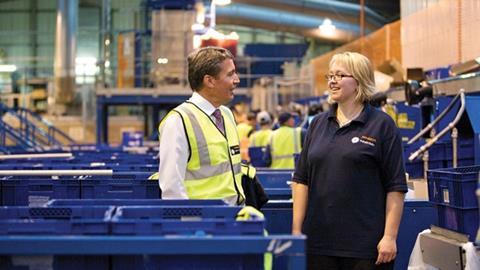After several years of investment and hard work, Sainsbury’s supply chain has overcome its availability problems. Charlotte Hardie reports

Standing in the middle of Sainsbury’s vast Hertfordshire depot in Rye Park, shouting over the incessant sound of clattering and whirring of its machinery, the sizeable weight that rests upon the shoulders of the grocer’s logistics director Dave King seems somehow magnified.
This is only one of the 23 Sainsbury’s depots dotted around the country, which last year handled more than 1 billion cases of product. If any one of those cases contains the wrong order for a store, then it could mean wastage, expense, empty shelves, lost sales and some very dissatisfied customers.
Shelf lives
Much of the focus of the Sainsbury’s supply chain team over the past few years has been on improving the retailer’s on-shelf availability, which, in the past, has been more than a little problematic. Poor availability had dogged the retailer ever since the hugely expensive implementation of the automated fulfilment system of picking goods in former chief executive Sir Peter Davis’ regime. And when Justin King joined as chief executive in 2004, he singled it out as one of the business’ biggest performance issues.
But thanks to investment and close scrutiny of the systems, those problems have gradually lessened and its supply chain today is barely recognisable to what it was several years ago. Pick accuracy in depots has contributed greatly. The target is 99.5%. “We’re beating that at 99.6%,” says logistics director King.
The Rye Park depot in particular is running at 99.7%. Sounds pretty good. After all, to the layman, what’s a couple of tenths of a percentage here and there? Actually, a lot. “With the scale of our operations, 99.6% still means there are a lot of cases that are picked incorrectly,” says King.
And so despite the improvements, he is determined that Sainsbury’s needs to be beating even higher targets and with a growing business new challenges arise all the time. To give an idea of the scale of the growth, this year about 200 million more cases of product left its depots than in 2004/5. Furthermore, the retailer’s march into the convenience sector and non-food categories means the operation is increasing all the time.
So where has the grocer gone wrong in the past and how has it rectified many of the problems?
“The biggest criticism that Peter Davis got was the pace of change - the sheer amount of change that was landing across the business at one time,” explains King. And when the automated picking systems were first introduced into the depot sites it was a “major drain on management time.”
He adds: “It was well documented that we didn’t get everything right in terms of implementation. There was a big learning process in how to operate these machines. The way we’re operating them now bears very little relevance to how we were operating them when we first started.”
Sainsbury’s has had to completely refine its processes. “We’re now much more reliable and so we have much more confidence in how we schedule our labour to the machines.”
Much of its efforts have concentrated on the people side of the supply chain, including working both with depot colleagues and drivers to revise their contracts. The shift patterns that some of the colleagues were working have changed. “Now we’re much more seven days a week, 24 hours a day, only stopping for Christmas. We’ve had a great response in terms of how people have changed their ways of working. We’re really centred around flexibility now, which means we’re much better aligned with customer needs,” he says.
Where mistakes do arise in sorting, it is often because of human error. To try and lessen that, Sainsbury’s has made significant efforts to try and work with all of its depot colleagues to help them improve. It holds improvement groups whereby mistakes made in areas such as product labelling or packaging are explained. It also incentivises staff, which it wasn’t doing to such an extent before. “It’s not massive, but it’s a small bonus,” says King. He adds, though, that depot staff are also randomly checked for accuracy - a store order is selected and scrutinised - and their pick accuracy is often 100%.
People power
Although many of the errors that are made are human ones, there has also been a recognition over the years that while automated picking has its place, it is not the solution to an efficient supply chain. As King says, while technology solutions will enhance the future of its supply chain, it is only one part of the equation. “It relies heavily on processes and our colleagues being in the right place at the right time and us being able to motivate and engage them to do the job,” he says.
For instance, in the early days of automated picking, King says the automated sorter used to run for about 20 hours of each day, sorting fresh product during the day time and late evening, and ambient product overnight to go into the stores during the day.
However, if there was any kind of breakdown or major delay, the ambient product was not getting sorted and out to stores. Sainsbury’s therefore removed automation for all ambient goods and replaced it with manual picking that can be done during the day instead of over 24 hours. “It wasn’t a sortation problem, it was the way it was configured,” explains King.
Transport management has been another area that has received much attention. It has introduced a new transport system called Integrated Transport Management System (ITMS). The advantage is that it enables Sainsbury’s to plan deliveries to the precise agreed store delivery window - again reducing the risk of empty shelves. It works by offering total control and visibility of the entire transport operation in real time, with technology such as in-vehicle computers and satellite tracking.
In the past three years ITMS has enabled the delivery of about 3.5 million more cases each week. “It’s about having the right stores served by the right depots geographically,” says King.
In addition, an overhaul of the transport system has made its supply chain significantly greener because of fuel savings.
And, of course, making improvements to a retail business’ long and complex supply chains would not be possible without working with suppliers. It has introduced significant enhancements to its replenishment systems at the head office in Holborn, and has focused on bringing about shorter lead times and reducing inventory.
Team effort
As part of a wider upgrade of its B2B integration - streamlining order management, invoicing, credit notes and so on - Sainsbury’s is also working with 4,000 suppliers to provide more supply chain intelligence using the Wesupply platform, which operates on the IBM e-business hosting infrastructure.
The aim is for suppliers to be more confident in the forecast demand and for Sainsbury’s to be more confident that suppliers can send exactly what has been ordered. Progress is expected to have been made by the end of this year.
As King says, the improvement that has been made with on-shelf availability is the result of work throughout the entire business. “From getting product from suppliers, to moving it through the supply chain to when it arrives in the store on to the shelves, it’s one big team game. What we’re doing here in the depots is driving accuracy so we deliver the right product to the right store at the right time to give colleagues every chance to get it onto the shelf.”
And that’s another issue altogether. Despite these improvements, this does not prevent gaps on shelves frequently arising. So how else do the problems arise even when the orders that leave the depot are correct? “It could be a combination of a number offactors,” says King. “It could be that we got the forecast wrong, that the weather was better in that part of the country so more people bought, say, salad. It could be that some of the processes broke down in store and there haven’t been enough hours to get the product out on to the shelf. It could be for a number of reasons - all of them unacceptable.”
Despite inevitable problems that will still occur, the vast strides that have been made within Sainsbury’s supply chain should not be underestimated. “The work we’ve done in the depots has played a major part in our recovery,” says King.
Managing a grocer’s supply chain operations must be one of the hardest jobs in the supply chain world. Because the vast majority of what it sells is fresh food, it is an around-the-clock, seven-days-a-week business. But for that very reason, says King, “I wouldn’t want to work anywhere else.”
Would a grocer ever really be able to achieve 100% on-shelf availability? “With all the tools we have, when it all comes together you can be 100% accurate,” he King. “It’s not impossible, so never say never.” And you get the impression he really means it.
The supply chain depends ultimately on people
- 1
- 2
 Currently reading
Currently readingA chain that won’t break
- 3
- 4
- 5
- 6































1 Reader's comment